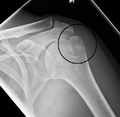Humerus fracture
| Humerus fracture | |
|---|---|
| Classification and external resources | |
|
Comminuted midshaft humerus fracture with callus formation | |
| ICD-10 | S42.2-S42.4 |
| AO | 11A1-13C3 |
| eMedicine | 1239985, 1261320 |
| MeSH | 68006810 |
A humerus fracture may be classified by the location of the humerus involved: the upper or proximal end, the shaft, or the lower distal.
Certain lesions are commonly associated with fractures to specific areas of the humerus. Proximal humerus fractures may occur at the surgical neck of the humerus[1] and anatomical neck of humerus[2] greater and lesser tubercles. This forms the basis for the Neer classification of fractures. Depending on the extent of the injury these fractures may be managed conservatively with a sling or require an open operation to internally fix the fragments. The axillary nerve can be damaged in fractures of this type leading to a neuropraxia however this may self-resolve. Avascular necrosis may also represent a complication of the fracture or open surgery associated with both deltopectoral (40%) or transdeltoid (10%) approaches during surgery.
Mid-shaft fractures may damage the radial nerve, which traverses the lateral aspect of the humerus closely associated with the radial groove. The median nerve is vulnerable to damage in the supracondylar area, and the ulnar nerve is vulnerable near the medial epicondyle, around which it curves to enter the forearm.
Radiographs are usually considered as a first-line imaging modality to evaluate clinically suspected humerus fracture. US, MRI, and CT are adequate alternatives if radiographs fail to demonstrate the cause of symptoms or do not sufficiently delineate the fracture for management purposes. CT is currently considered the gold standard to diagnose, but has limitations to detect adjacent soft tissue disorders. Depiction of greater tuberosity fractures at US is not uncommon in trauma setting because the fracture may be missed or overlooked at baseline radiographs and the patient will then present for US to scan rotator cuff for abnormalities.[3]
-

A fracture of the greater tuberosity as seen on AP X ray
-

A fracture of the greater tuberosity of the humerus
-

Fracture of the greater tuberosity of the humerus
-

Proximal humerus fracture
See also
- Supracondylar fracture
- Holstein-Lewis fracture
- Milch classification
- Gartland classification
- Supracondylar humerus fracture
References
- ↑ "Surgical Neck Fractures of the Humerus - Wheeless' Textbook of Orthopaedics". Retrieved 2007-08-16.
- ↑ "Anatomic Neck Fracture of Humerus - Wheeless' Textbook of Orthopaedics". Retrieved 2007-08-16.
- ↑ Arend CF. Ultrasound of the Shoulder. Master Medical Books, 2013. Free section on proximal humerus fracture available at ShoulderUS.com
External links
| ||||||||||||||||||||||||||||||||||||||||||||||||||||||||||||||||||||||||||||||||||||||||||||||||||
